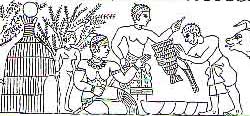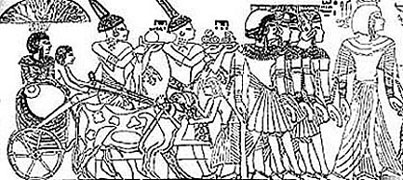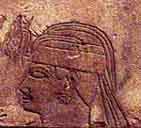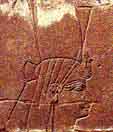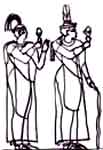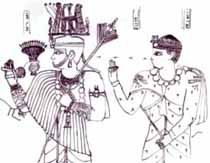Daily LifeClothingThe Kushites wore diverse types of clothing. Excavated graves dating to early periods of Sudanese history indicate that clothes were mostly made of leather and linen fibers. Loin clothes, kilt, and sandals were uncovered in considerable amounts in the Kerma graves. Clothes also showed signs of heavy coloration. Jewelry was found in large amounts throughout Kushite graves including necklaces, bracelets, earrings, finger rings, ostrich feathers, and beads of faience.
Men in Kushite graves were usually accompanied with loin clothes and tunics made of linen. Women were accompanied with simple long skirts but were often bare chested. A pastoral scene engraved in a bronze bowl dating to the second
century CE, depicts Kushite men wearing tunics that were tucked under
their belts and tied to their fronts in a butterfly tie (see
the figure to the left). A seated women is depicted wearing a squire
piece of cloth with tassels dangling from its lower edge. The woman
is also shown wearing heavy ornaments including a headband, a large
bracelet, and armlets. Royal Clothing in Early Nubia Rich graves were excavated in Sudan containing abundant types of clothes such as leather loincloths and tunics. Personal ornament materials were also abundantly discovered, such as kohl pots, and jewelry made of finance beads, ostrich shells, copper, and ivory.
Clothing of the Pharaohs of the Napatan period:
Clothing of the royal women of the Napatan period:
Clothing of the royal pharoahs of the Meroitic period:
The Meroitic Pharaoh is usually depicted wearing the traditional skullcap with the two uraei (the Eye of Re) projecting from them. A heavily decorated headband was sometimes tied around the head. This type of crown was usually accompanied with a tight leather dress with long sleeves. The dress, like most Meroitic clothes, is heavily decorated with complex designs. Pharaohs and queens wore other types of dresses. However, the most common one is consisted of a long skirt that reached the ankles; over which a fringed shawl was sometimes worn. A long robe is usually depicted dangling with three tassels. Different types of crowns are depicted. In a temple, at Naqa, a pharaoh is depicted wearing a skullcap that supported two horns. At the ends of each horn is a urea. Farther more, above each horn rose three feather like objects (see the figure above). Meroitic pharaohs usually wore sandals. One stripe of the sandal crossed over the back of the ankle, a second stripe crossed over the front, and a third stripe connected the front stripe to the sole of the toe. Some sandals had leather extensions that provided a protective cover to the heel, while another stripe extended from the sole of the toe to another stripe that ran across the foot. Meroitic pharaohs and queens wore extensive jewelry including hand bands, bracelets, necklaces, girdles, earrings, anklets, and finger rings. Unfortunately not much archeology had been done regarding this period. Some of the excavated tumuli at Balana revealed few cotton materials. However since Sudan is notorious for its cotton production, cotton was certainly the main material used for making fiber in the ancient Sudan. Clothing of the royal women of the Meroitic period:
Royal clothing of the X-Group:
One relief at Kalabsha dating to the fifth century CE, depicts a king wearing fancy cloth with crowns (see the figure to the right). The first and larger relief depicts the king riding on a horse wearing a kilt up to his knees decorated with bands that were probably colored. The figure is also depicted wearing a thick belt decorated with vertical bands and a horizontal band on each edge. On his chest he wore a shield of, probably, leather or iron. He wore a couple of armlets and bracelets. His chest is covered with a rectangular piece of cloth with an opening for the head. The piece is decorated with vertical bands and tassels aligned along its bottom edge. The king wore a band that is tied around his head and a crown held on two horns of a ram. The upper part of the crown is consisted of three leaf-like shapes with spherical objects at their top ends. A secondary part of the relief, depicts a king wearing the same kind of skirt and a chest shield extending below the armpits. Two horizontal bands decorate the top and bottom ends of the shield. The shield is held by belts that pass over the shoulders and meet at the middle of the upper edge of the shield. Around his neck he is depicted wearing a broad collar decorated with vertical bands. On his head, he wears a crown shaped like a cylinder. From the inside of the cylender-crown a second crown emerges towards the top shaped like a plum and conglobed at its top-end. Farther Readings:
Edited: Dec. 2008. |
